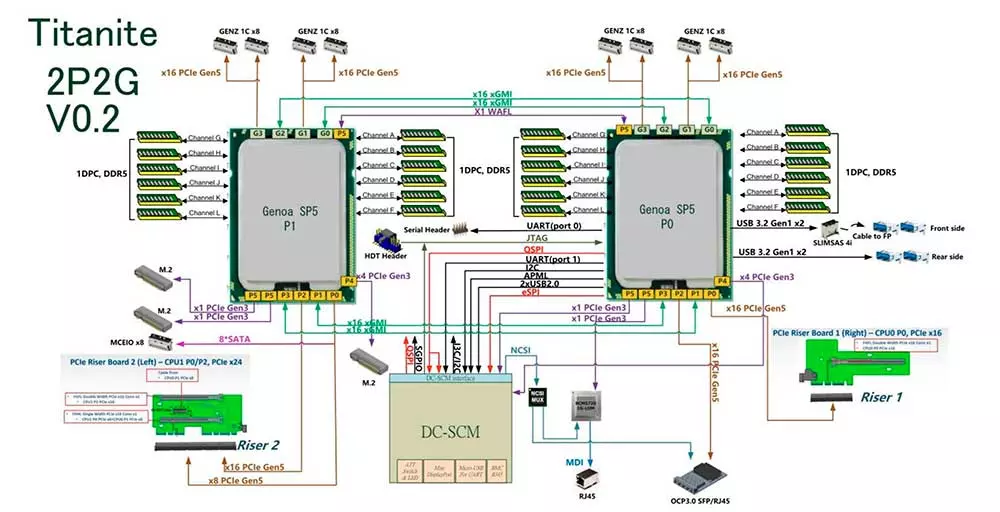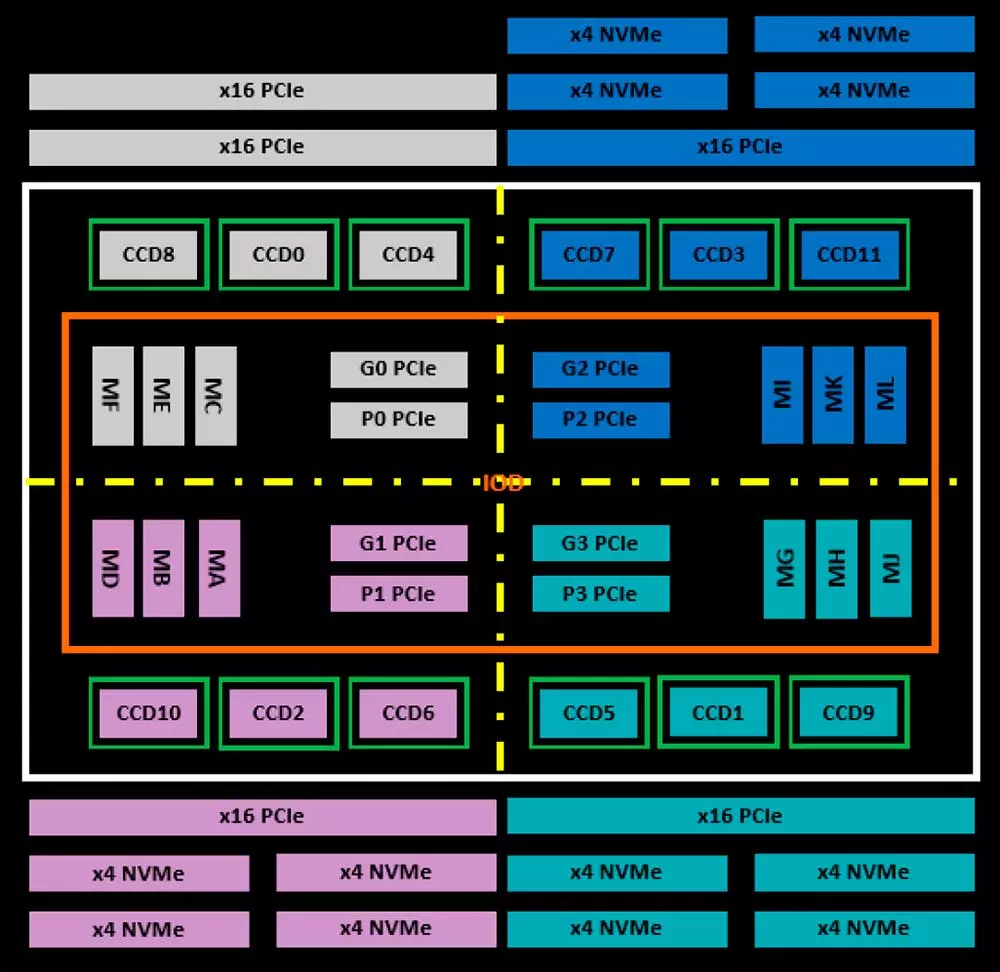
The recent hack of GIGABYTE has shown what AMD is going to launch against Intel in the server arena and at the same time has revealed part of the potential that Zen 4 will have as a desktop architecture. The filtering is so complete and with characteristics that are really scary, since we are very close to the presentation date and AMD raises the bar a lot more with EPYC: up to 96 cores with infernal consumption and an IPC improvement greater than that of Zen 3. That’s right AMD EPYC Genoa with Zen 4.
Before we start to reel off the filtering, we must consider from the outset that if this information ends up becoming reality and is reliable, then Intel has a serious problem. And it is that with the new EPYC Genoa processors the company is going to increase the level a lot, where it will not leave too much space for its rival already in 2022.
GIGABYTE hack begins to reveal AMD details
As we already know, AMD EPYC Genoa will arrive in a high performance 5nm lithographic process manufactured by TSMC under the next generation Zen 4 architecture. The leaking is overwhelming, so better let the numbers speak:
- AMD Zen 4 CCD: 10.70 x 6.75 mm (72.225 mm2)
- AMD Zen 4 IOD: 24.79 x 16.0 mm (396.64 mm2)
- AMD EPYC Genoa Substrate (Package): 72.0 x 75.40 mm (5428 mm2)
- Socket AMD SP5 LGA 6096 – 76.0 x 80.0 mm (6080 mm2)
A Zen 4 CCD is estimated to be 11% smaller than current Zen 3s, the IOD is 5% more compact, while the socket and package size has skyrocketed their numbers. The reason is simple, AMD will go from 64 cores to 96 cores and for this it will include 4 more CCDs per CPU.





As a detail and taking into account that the figures are overwhelming, it must be taken into account that the package is almost as big as the socket itself and seeing that it will house a whopping of 6096 pins we are talking about the largest socket that AMD has ever created in its history.
A peak consumption of 700 watts for the CPU only






The numbers are staggering, yes, but the requirements to get one of these CPUs and keep them well-equipped are no less. What was revealed in GIGABYTE shows that the new LGA 6096 SP5 socket will need 700 watts for 1 millisecond at peak of the platform and for the largest of its processors. As sustained consumption for 10 ms we speak of 440 watts, while the maximum power in PCC will be 600W, almost nothing.
Dizzying numbers, no doubt, but this also has a good part: according to the latest rumors, the CPI would have risen to + 29% and in multitasking to same cores it would have increased by + 40%.


















If to this we add the 96 cores and 192 threads as a TOP bet, we have a winning horse without a doubt, but there is more. The filtering also reveals a large number of processors with different configurations and TDP:
- 96 cores / 192 threads – 400W TDP 13 Chiplets (124W IOD Power / 6.7W LGA Power)
- 64 cores / 128 threads – 400W TDP 9 Chiplets (117W IOD Power / 6.7W LGA Power)
- 96 cores / 192 threads – 320 W TDP 13 Chiplets (124 W IOD Power / 5.3 W LGA Power)
- 64 cores / 128 threads – 320 W TDP 9 Chiplets (117 W IOD Power / 5.3 W LGA Power)
- 96 cores / 192 threads – 300W TDP 13 Chiplets (126W IOD Power / 5W LGA Power)
- 32 cores / 64 threads – 300 W TDP 9 Chiplets (119 W IOD Power / 5 W LGA Power)
- 96 cores / 192 threads – 280W TDP 13 Chiplets (126W IOD power / 4.7W LGA power)
- 64 cores / 128 threads – 280 W TDP 9 Chiplets (116 W IOD Power / 4.7 W LGA Power)
- 64 cores / 128 threads – 260 W TDP 9 Chiplets (118 W IOD Power / 4.3 W LGA Power)
- 32 cores / 64 threads – 260 W TDP 9 Chiplets (118 W IOD Power / 4.3 W LGA Power)
- 48 cores / 96 threads – 240W TDP 9 Chiplets (117W IOD Power / 4.0W LGA Power)
- 24 cores / 48 threads – 240W TDP 5 Chiplets (117W IOD Power / 4.0W LGA Power)
- 48 cores / 96 threads – 200 W TDP 9 Chiplets (117 W IOD Power / 3.3 W LGA Power)
- 24 cores / 48 threads – 200W TDP 5 Chiplets (117W IOD Power / 3.3W LGA Power)
- 16 cores / 32 threads – 195W TDP 5 Chiplets (116W IOD Power / 3.3W LGA Power)
- 8 cores / 16 threads – 195W TDP 5 Chiplets (116W IOD Power / 3.3W LGA Power)
- 16 cores / 32 threads – 155W TDP 5 Chiplets (116W IOD Power / 2.6W LGA Power)
- 8 cores / 16 threads – 155W TDP 5 Chiplets (116W IOD Power / 2.6W LGA Power)
AMD EPYC Genoa Zen 4, does it have real competition?
Taking into account that the official TDP rises a lot and that we now have 13 chips inside a CPU (12 CCDs with up to 8 cores for each of them plus the IOD), that the number of PCIe lines is 128 in version 5.0 ( 112 available apparently, 16 reserved for dual socket configurations) and impressive support for DDR5-5200 with 12 channels and 2 DIMMs for each of them (6400 MT / s in the Refresh versions), the TDP rise does not seem so wide and when we know the frequencies we can calculate efficiencies.
Given the leaked, can Intel with Sapphire Rapids be a rival to these monsters?
The post They filter everything about AMD Zen 4 EPYC CPUs: 96 Cores, 700W and DDR5-6400 appeared first on HardZone.





